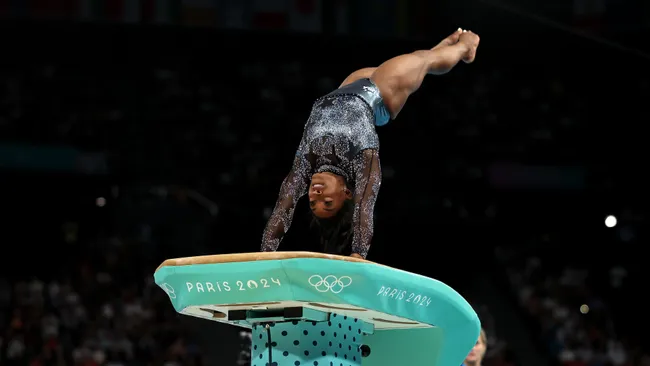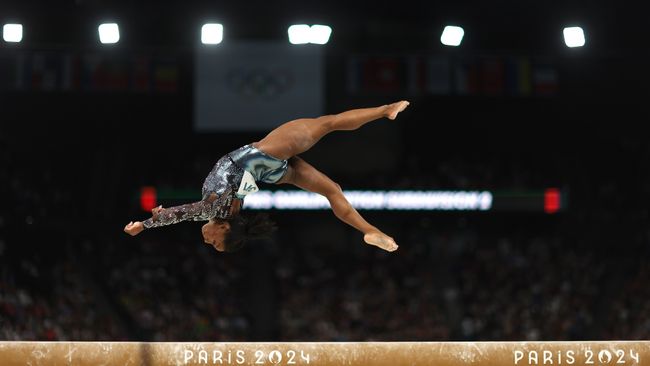Simone is a very, very rare bird’: Experts discuss the science behind Simone Biles’ gymnastic prowess

With eight Olympic medals and 30 World Championship medals under her belt — and potentially more to come soon — U.S. gymnast Simone Biles is considered one of the greatest gymnasts of all time.
So what’s the science behind her success?
There’s a certain “X factor” that Gina Pongetti, a former gymnast and physical therapist who is treating athletes at the 2024 Paris Olympics, calls “Simone being Simone.” Beyond that, the answer lies in Biles’ dedicated training of her neuromuscular system — everything from the ribbon of tissue that traverses the frontal lobe in the brain and controls movement to the sensory receptors that provide feedback to the muscles themselves.

To be an elite athlete is one level,” Pongetti told Live Science. “To step up to Simone’s level involves an absolute keen understanding of her body and the input signals that come to it.”
Biles stands out from other gymnasts both in terms of how she senses her body in space and how she hones her muscle memory, “as well as [her] having one of the most phenomenal bases of strength and conditioning that I’ve ever seen in an athlete,” Pongetti added
Biles started gymnastics at 6 years old. A youthful start is common among elite gymnasts; growing brains are adept at taking in information, said Dr. David Neuman, a fellow of the American Academy of Orthopedic Surgery and clinical director NY Sportscare in Manhattan. And that early practice, he told Live Science, often provides a basis for later adeptness.
Particularly important to gymnasts is proprioception, the sense of where one’s body is in space. The sense depends on signals from specialized cells within muscles, tendons and joints. In muscles, for example, bundles of nerves called muscle spindles tell the brain how stretched or contracted a muscle is. In the skin and joints, receptors known as Pacinian corpuscles react rapidly to sensations of pressure.
When Biles competes on the vault, these corpuscles are one of her key informants as to how squarely her palms hit the apparatus and if she’s effectively transferred the force she needs to launch into and twist through the air.
None of those decisions are conscious. The movements happen so quickly that the motor planning has to be preordered in advance, Pongetti explained. She compared it to a fireworks show, in which fuses of different lengths are lit at the same time. The programmed sequence is triggered when the gymnast takes their first step. In motor learning, linking together movements in this way is called “chunking,” said Gregory Youdan, an independent movement scientist and dancer in New York City
Because it’s chunked, it frees up a little bit more cognitive load for other things and allows for that automaticity,” Youdan told Live Science.

PARIS, FRANCE – JULY 28: Simone Biles of Team United States competes on the balance beam during the Artistic Gymnastics Women’s Qualification on day two of the Olympic Games Paris 2024 at Bercy Arena on July 28, 2024 in Paris, France. (Photo by Naomi Baker/Getty Images)
Because it’s chunked, it frees up a little bit more cognitive load for other things and allows for that automaticity,” Youdan told Live Science.
Then, throughout the sequence, the proprioception system tells the athlete if all is going well. The muscles and fascia — the nerve-rich casing that covers the muscles and organs — respond accordingly with the required movements to make tiny correction
And that’s where Biles’ famous work ethic comes in. To reach that level of automaticity, gymnasts have to practice perfectly, Pongetti said. It’s a stepwise process that begins in a gym’s loose-foam pit, a swimming-pool-like structure filled with foam cubes where gymnasts can fall without hurting themselves. From there, the athletes slowly build up to doing the routine on the gymnastics floor, without padding.
“As each step progresses, your level of confidence should increase, thereby allowing you to take more risks of a less-forgiving landing,” Pongetti said.
In a 2004 study, scientists used a sequence of finger movements — rather than gymnastic routines — to investigate how this type of memorized motor learning becomes automatic. The same brain areas lit up when people were first learning the finger movements and after they learned to do them automatically. However, brain activity declined slightly in many regions once the movement became automatic, suggesting that automaticity stems from an increase in singaling efficiency.
News
Dre must pay his ex-wife $3.5 million per year
Rapper Dr. Dre was ordered by the court to pay his ex-wife Nicole Young $3.5 million per year after the divorce. On July 22, People’s source said that a judge in Los Angeles asked Dr. Dre (real name Andre Romelle…
Dr. Dre Poses with ‘Hero’ Paul McCartney in Instagram Snap: ‘Paul McCartney Is Cool AF’
The seven-time Grammy-winning rapper documented the epic moment when he met Sir Paul McCartney, whom he called one of his “heroes” PHOTO: DR. DRE/INSTAGRAM Even Dr. Dre gets starstruck! The seven-time Grammy-winning rapper, 56, met one of his “heroes” — Sir Paul McCartney —…
Marsha Ambrosius & Dr. Dre Announce New ‘Casablanco’ Joint Album/Says It’s Some of Their Best Work!
Marsha Ambrosius & Dr. Dre Announce New ‘Casablanco’ Joint Album/Says It’s Some of Their Best Work! It’s been a hot minute since we’ve heard some new music from Marsha Ambrosius but her brief hiatus is about to come to an end. The…
Lil Eazy-E Calls Out Dr. Dre For Not Being Present At Street Naming: “All Of The West Coast Should Be”
He called out the fact that Dre wasn’t present during the street naming. In a recent interview with TMZ at the unveiling of the street named after his late father, Eazy-E, Lil Eazy-E had some words for Dr. Dre. In fact, issued a public…
EAZY-E HAS ‘REELS’ OF UNRELEASED MUSIC: ‘HE HAD SONGS WITH GUNS N’ ROSES’
On March 26, 1995, Hip-Hop lost one of its greatest visionaries when Eric “Eazy-E” Wright passed away at only 30 years old. Shortly before his passing, Eazy had just patched up old wounds with Ice Cube in a moment that was depicted in the…
DR. DRE ANNOUNCES NEW ALBUM WITH MARSHA AMBROSIUS
Dr. Dre has announced he’s completed an entire album with Floetry singer Marsha Ambrosius. The West Coast legend took to Instagram on Sunday (December 12) to announce the project titled Casablanco, while sharing a selfie with a room full of musicians. KEVIN MAZUR/GETTY IMAGES FOR…
End of content
No more pages to load











